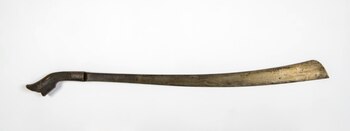| Ladieng | |
|---|---|
 A Ladieng from
Aceh, pre-1911. | |
| Type | Klewang sword / Parang (knife) |
| Place of origin | Indonesia ( Aceh & North Sumatra) |
| Service history | |
| Used by | Acehnese people, Gayo people, Alas people |
| Specifications | |
| Length | overall length: approx. 66–77 cm (26–30 in) |
| Blade type | Straight single edged |
| Hilt type | Wood, Horn |
The Ladieng (also known as Klewang-Ladieng, Ladeng, Ladeeng, Roedoes Lentik, Rudus Lenti, Sonagang-Klewang) is a sword from Sumatra, Indonesia. It is also commonly known as Parang Lading in Malaysia.
It is originally thought to be an agricultural tool used for cutting brushwood and grass, [1] that has made its way into Malay martial arts, Silat and as a weapon. [2] Unfortunately it is too a convenient weapon of offence by gang robbers. [1]
Description
The Ladieng has a slightly curved, single-edged blade. The blade widens from the hilt to the tip. It is slightly curved, has neither a central ridge nor a hollow ground and is rounded in place. Many of the blades were made from Damascus steel. The lines in the steel are called kuree by the Acehnese people and kure by the Gayo people and Alas people. The hilt has no guard, is made of wood and decorated with traditional carvings. The Ladieng is available in various versions, which differ in blade and handle shape. In Aceh it is called Ladieng, in Gayo and Alas Rudus Lenti. It is used by various ethnic groups in Sumatra. The Ladieng is a version of the klewang. [3]
See also
References
- ^ a b James Low (1836). A Dissertation on the Soil & Agriculture of the British Settlement of Penang, Or Prince of Wales Island, in the Straits of Malacca: Including Province Wellesley on the Malayan Peninsula. With Brief References to the Settlements of Singapore & Malacca. Printed at the Singapore Free Press Office. p. 12. OCLC 7391101780.
- ^ Mariana Isa & Maganjeet Kaur (2015). Kuala Lumpur Street Names: A Guide to Their Meanings and Histories. Marshall Cavendish International (Asia) Pte Limited. ISBN 97-898-1472-144-8.
- ^ Albert G Van Zonneveld (2002). Traditional Weapons of the Indonesian Archipelago. Koninklyk Instituut Voor Taal Land. p. 79. ISBN 90-5450-004-2.


